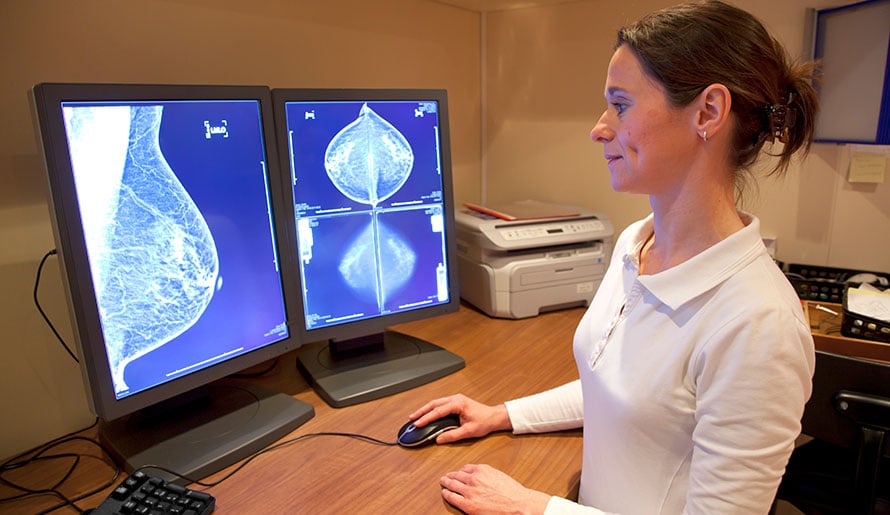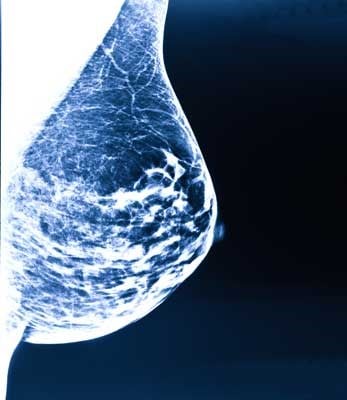Breast Cancer Stages

Staging is a complex process used by physicians to determine how much cancer a patient has and which parts of his or her body are affected. In addition to its extent and location, breast cancer is classified based on its genetic makeup, its sensitivity to certain hormones and whether it tests positive for specific proteins that can promote its growth.
After evaluating these factors, a physician can assign a stage to breast cancer. The physician may then use this information to describe the cancer, determine the patient’s prognosis and plan treatment.
TNM staging of breast cancer
After a breast cancer diagnosis is confirmed, the staging process typically begins with a physical examination, imaging scans and a biopsy of a tumor tissue sample. The most common method of staging breast cancer uses the American Joint Committee on Cancer (AJCC) TNM system, which involves an analysis of three key measures:
- T – Tumor size
- N – Lymph node status (the number and location of any cancerous lymph nodes)
- M – Metastasis (whether or not the cancer has spread to other parts of the body)
When using the TNM system for breast cancer staging, a physician will consider several additional factors, including:
The grade of the tumor
When examining the tissue sample under a microscope, a pathologist will visually compare the breast cancer cells to healthy cells, then assign a tumor grade based on the degree of similarity between them. In general, the more the cancerous cells resemble normal cells, the lower the grade assigned. Additionally, the pathologist will determine the number of cancerous cells that are in the process of dividing. If relatively few breast cancer cells are dividing, the tumor is generally considered to be slow-growing and may be downgraded.
The tumor grades used to classify breast cancer are:
- Grade 1 – The cancerous cells look relatively normal, and the tumor is slow-growing (well-differentiated).
- Grade 2 – The appearance and division rate of the cancerous cells fall somewhere in between grade 1 and grade 3 (moderately differentiated).
- Grade 3 – The cancerous cells have a very abnormal appearance, and the tumor is fast-growing (poorly differentiated).
The hormone receptor status of the tumor
Some types of breast cancer are fueled by certain hormones produced naturally by the body, such as estrogen and progesterone. These breast cancer cells have special proteins (hormone receptors) on their surface. After binding to the hormone receptors, the hormones can accelerate the growth of the tumor.
When performing a biopsy, a pathologist can test the tumor tissue to determine its hormone receptor status. The breast cancer will be classified as estrogen-receptor-positive (ER+) if it has receptors for estrogen, which suggests that the cancerous cells, like healthy breast cells, may receive signals from estrogen that could promote their growth. Likewise, the breast cancer will be classified as progesterone-receptor-positive (PR+) if it has receptors for progesterone.
The HER2 status of the tumor
Human epidermal growth factor receptor 2 (HER2) is a protein found on the surface of some breast cancer cells. HER2 plays an integral role in the growth and survival of the cancer cells. During a biopsy, a pathologist can test the tumor sample for HER2; if this protein is detected, the cancer is classified as HER2-positive breast cancer.
 The staging scale for breast cancer
The staging scale for breast cancer
Based on a comprehensive evaluation of the above factors, the physician will assign a stage to the cancer. Breast cancer is staged based on a numerical scale that ranges from 0 to 4:
Stage 0 breast cancer
At stage 0, breast cancer is noninvasive and confined to the lining of the milk ducts or breast lobes (ductal carcinoma in situ (DCIS) or lobular carcinoma in situ (LCIS), respectively). There is no evidence that precancerous cells or breast cancer cells have invaded nearby healthy tissues.
Stage 1 breast cancer
At stage 1, breast cancer cells have spread from the milk ducts or lobes into the surrounding breast tissues but remain contained within a relatively small area. The cancer is classified as stage 1A if the breast tumor is smaller than 20 mm in diameter (the size of a grape) and has not spread to nearby lymph nodes.
The cancer is classified as stage 1B if small clusters of breast cancer cells are found in nearby lymph nodes and:
- The breast tumor is larger than 20 mm in diameter; or
- There is no breast tumor, but cancerous cells in the breast tissues have formed clusters that are between 0.2 and 2 mm in diameter.
Stage 2 breast cancer
At stage 2, breast cancer is locally invasive and growing, but still contained within the breast and/or the surrounding lymph nodes.
The cancer is classified as stage 2A if:
- The breast tumor is smaller than 2 cm in diameter and breast cancer cells are found in the lymph nodes in or around the armpit (axillary lymph nodes); or
- The breast tumor is between 2 and 5 cm in diameter but breast cancer cells have not spread to the axillary lymph nodes; or
- There is no breast tumor, but cancerous masses larger than 2 mm in diameter are found in up to three axillary lymph nodes.
The cancer is classified as stage 2B if:
- The breast tumor is between 2 and 5 cm in diameter and breast cancer cells have spread to up to three axillary lymph nodes; or
- The breast tumor is larger than 5 cm in diameter, but breast cancer cells have not spread to the axillary lymph nodes; or
- There is no breast tumor, but a tumor in a nearby lymph node is between 2 and 5 cm in diameter and other breast cancer cells have formed clusters that are between 0.2 and 2 mm in diameter.
Stage 3 breast cancer
At stage 3, the breast cancer is regionally invasive and has spread beyond the breast tissue and nearby lymph nodes but has not reached distant tissues or organs.
The cancer is classified as stage 3A if:
- The breast tumor is larger than 5 cm in diameter and breast cancer cells in the lymph nodes have formed clusters that are between 0.2 and 2 mm in diameter; or
- The breast tumor is larger than 5 cm and breast cancer cells have spread to up to three axillary lymph nodes; or
- There is no breast tumor, but a tumor is growing alongside breast cancer cells in four to nine axillary lymph nodes.
The cancer is classified as stage 3B if a breast tumor of any size has spread into the chest wall or breast skin and up to nine axillary lymph nodes.
The cancer is classified as stage 3C if there is no breast tumor or a breast tumor of any size has spread into the chest wall or breast skin, and breast cancer cells have spread to 10 or more axillary lymph nodes.
Stage 4 breast cancer
At stage 4, breast cancer is metastatic and has entered the lymphatic system or bloodstream and spread to distant tissues or organs, such as the lungs, liver, bones or brain.
Although Stage 4 breast cancer is not curable, it is usually treatable. Due to continuing research breakthroughs and advances in medical technology, more breast cancer patients are living longer and fuller lives. In some cases, stage 4 breast cancer can be managed as a chronic illness with a dual goal to ensure the best possible outcome and quality of life.
What stages of breast cancer require a mastectomy?
In general, a treatment plan for breast cancer at any stage will include a combination of surgery, chemotherapy, radiation therapy, immunotherapy, hormone therapy and/or targeted therapy. The most commonly performed surgical procedures to treat breast cancer are a mastectomy and a lumpectomy.
A mastectomy involves the surgical removal of all breast tissue from a breast. For a patient who is diagnosed with Stage 1 or 2 (early-stage) breast cancer, a mastectomy may be one treatment option. A lumpectomy, which involves the surgical removal of a discrete portion of breast tissue that contains a tumor, may be another option. The main difference between the two is that a mastectomy removes the entire breast, while a lumpectomy preserves the breast.
The choice between having a mastectomy and a lumpectomy is a highly personal one. Studies show that both procedures are effective in preventing a recurrence of breast cancer. Even so, some patients prefer to undergo a mastectomy for their own reasons.
In some cases, a surgeon can utilize advanced mastectomy techniques to preserve breast skin and allow for a more natural breast appearance after the procedure. Additionally, some patients choose to undergo breast reconstruction surgery to restore the shape of the breast at the same time as a mastectomy or during a second procedure performed later.
In addition to breast cancer treatment, a patient may choose to undergo a mastectomy for breast cancer prevention.
Mastectomy for breast cancer treatment
A mastectomy may be a treatment option for several types and stages of breast cancer, including:
- Stage 0 ductal carcinoma in situ (DCIS) or other noninvasive breast cancer
- Stages 1 and 2 (early-stage) breast cancer
- Stage 3 (locally advanced) breast cancer after chemotherapy
- Inflammatory breast cancer after chemotherapy
- Paget’s disease of the breast
- Locally recurrent breast cancer
A physician may suggest a mastectomy instead of a combination of a lumpectomy and radiation therapy for a patient who:
- Is pregnant
- Has two or more tumors in distinct areas of the cancerous breast
- Has cancerous microcalcifications throughout the breast
- Has previously undergone radiation therapy and the cancer has recurred in the breast
- Has undergone a lumpectomy but cancer remains at the edges (margin) of the surgical site
- Has a large tumor in relation to the overall size of the breast
- Has a connective tissue disease, such as scleroderma or lupus, and may not be able to tolerate the side effects of radiation therapy on the skin
- Has a genetic mutation that increases the risk of developing another cancer in the breast
Mastectomy to prevent breast cancer
Some patients choose to undergo a mastectomy—even though they have not been diagnosed with breast cancer—if they have a very high risk of developing the disease either due to a strong family history of breast cancer or the confirmed presence of certain genetic mutations. Also known as a preventive (prophylactic) or risk-reducing mastectomy, this procedure involves removing both breasts to significantly reduce the risk of developing breast cancer in the future.
Getting medical help for any stage of breast cancer at Moffitt Cancer Center
As Florida’s top cancer hospital, Moffitt Cancer Center has disrupted the traditional patient care model. To ensure the best possible outcomes, we provide our patients with rapid care so they can begin treatment as soon as possible. The multispecialty team in our Don & Erika Wallace Comprehensive Breast Program offers the latest treatment options for all stages of breast cancer. For information about our evidence-based techniques and individualized treatment approach, complete our new patient registration form online or call 1-888-663-3488. A referral is not required.
References
American Cancer Society – Breast Cancer Stages
National Breast Cancer Foundation, Inc. – Stage 4 Breast Cancer
Breastcancer.org – More Women Choosing Mastectomy Over Lumpectomy
Diagnosis
